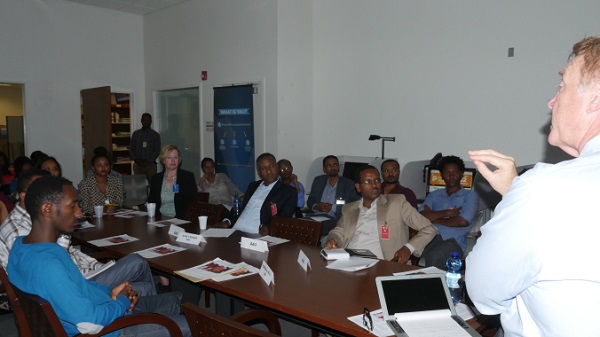
Ethiopia’s lack of participation in the international intellectual property system makes it harder – and more expensive – to protect its registered trademark names.
By Justin Hughes, JD
ADDIS ABABA, Ethiopia (U.S. Embassy)–It’s been a pleasure to come to Ethiopia as part of the U.S. State Department’s public speaker series; the State Department invited me here to talk about intellectual property (IP) laws as well as international trade, the two subjects I teach at Loyola Law School at Loyola Marymount University in Los Angeles. During my trip, I’ve spoken before audiences from Addis Ababa and Hawassa universities; conducted a 1.5 day workshop for the Ethiopian Intellectual Property Office (EIPO), and had many smaller meetings and site visits, including the Ethiopian Agricultural Research Institute in Addis, the Oromia Coffee Farmers’ Cooperative Union in Oromia, and rural health centers and health posts in Amhara.
One of my primary interests on this trip is to understand better Ethiopian coffee production. For many years, I have been thinking and writing about how one kind of IP, “geographical indications,” can be used to improve the income of farmers in developing countries. Ethiopia currently protects its most important coffee region names – SIDAMO, HARRAR, and YIRGACHEFFE – as registered trademarks in the United States, but it is not clear that this marketing and legal strategy has produced the optimal results. And Ethiopia’s lack of participation in the international IP system makes it harder – and more expensive – to protect those names in countries where high-end coffees can be marketed at a premium. (I’ll explain Ethiopia’s absence from the international IP system in the next blog.)
At the same time, over the past couple decades Ethiopia has shifted back and forth on how centralized the control of coffee exports should be. The recent decentralization of coffee exports has permitted more direct contacts – and contracts – between farmers (or farmers’ cooperatives) and buyers from abroad. That’s good for both sides: farmers can get higher payments by eliminating the middle man, buyers can have more confidence in the coffee’s origin and quality, and both sides can communicate learn from each other. To raise coffee farmers’ incomes that trend needs to continue, along with stronger marketing of Ethiopia’s coffee regions and better systems for “traceability” of Ethiopia’s coffees (which will happen as more cooperatives sell directly to exporters).
All that needs to be accompanied by appropriate intellectual property protection, especially “certification mark” protection in countries that offer such protection. So, it’s been wonderful for me to get to talk about all these issues with both Ethiopian coffee and IP experts. Stay tuned for more…
(Professor Justin Hughes teaches international trade and intellectual property courses at Loyola Law School, Loyola Marymount University, in Los Angeles, California.)
Source: U.S. Embassy – Addis Ababa
——
Other stories:
